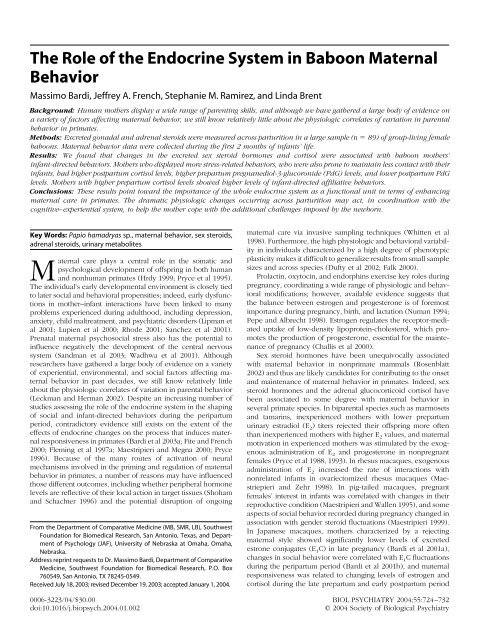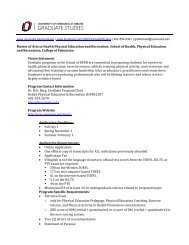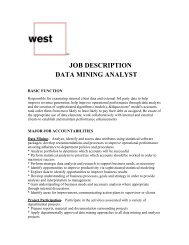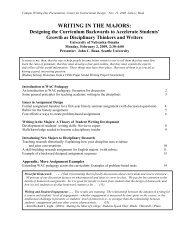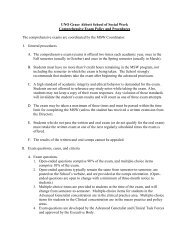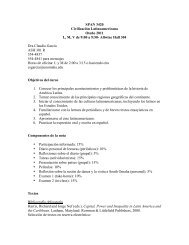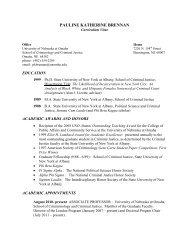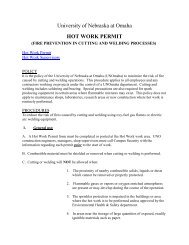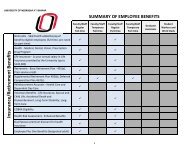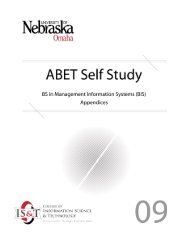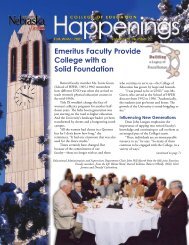The Role of the Endocrine System in Baboon Maternal Behavior
The Role of the Endocrine System in Baboon Maternal Behavior
The Role of the Endocrine System in Baboon Maternal Behavior
You also want an ePaper? Increase the reach of your titles
YUMPU automatically turns print PDFs into web optimized ePapers that Google loves.
<strong>The</strong> <strong>Role</strong> <strong>of</strong> <strong>the</strong> <strong>Endocr<strong>in</strong>e</strong> <strong>System</strong> <strong>in</strong> <strong>Baboon</strong> <strong>Maternal</strong><br />
<strong>Behavior</strong><br />
Massimo Bardi, Jeffrey A. French, Stephanie M. Ramirez, and L<strong>in</strong>da Brent<br />
Background: Human mo<strong>the</strong>rs display a wide range <strong>of</strong> parent<strong>in</strong>g skills, and although we have ga<strong>the</strong>red a large body <strong>of</strong> evidence on<br />
a variety <strong>of</strong> factors affect<strong>in</strong>g maternal behavior, we still know relatively little about <strong>the</strong> physiologic correlates <strong>of</strong> variation <strong>in</strong> parental<br />
behavior <strong>in</strong> primates.<br />
Methods: Excreted gonadal and adrenal steroids were measured across parturition <strong>in</strong> a large sample (n 89) <strong>of</strong> group-liv<strong>in</strong>g female<br />
baboons. <strong>Maternal</strong> behavior data were collected dur<strong>in</strong>g <strong>the</strong> first 2 months <strong>of</strong> <strong>in</strong>fants’ life.<br />
Results: We found that changes <strong>in</strong> <strong>the</strong> excreted sex steroid hormones and cortisol were associated with baboon mo<strong>the</strong>rs’<br />
<strong>in</strong>fant-directed behaviors. Mo<strong>the</strong>rs who displayed more stress-related behaviors, who were also prone to ma<strong>in</strong>ta<strong>in</strong> less contact with <strong>the</strong>ir<br />
<strong>in</strong>fants, had higher postpartum cortisol levels, higher prepartum pregnanediol-3-glucoronide (PdG) levels, and lower postpartum PdG<br />
levels. Mo<strong>the</strong>rs with higher prepartum cortisol levels showed higher levels <strong>of</strong> <strong>in</strong>fant-directed affiliative behaviors.<br />
Conclusions: <strong>The</strong>se results po<strong>in</strong>t toward <strong>the</strong> importance <strong>of</strong> <strong>the</strong> whole endocr<strong>in</strong>e system as a functional unit <strong>in</strong> terms <strong>of</strong> enhanc<strong>in</strong>g<br />
maternal care <strong>in</strong> primates. <strong>The</strong> dramatic physiologic changes occurr<strong>in</strong>g across parturition may act, <strong>in</strong> coord<strong>in</strong>ation with <strong>the</strong><br />
cognitive–experiential system, to help <strong>the</strong> mo<strong>the</strong>r cope with <strong>the</strong> additional challenges imposed by <strong>the</strong> newborn.<br />
Key Words: Papio hamadryas sp., maternal behavior, sex steroids,<br />
adrenal steroids, ur<strong>in</strong>ary metabolites<br />
<strong>Maternal</strong> care plays a central role <strong>in</strong> <strong>the</strong> somatic and<br />
psychological development <strong>of</strong> <strong>of</strong>fspr<strong>in</strong>g <strong>in</strong> both human<br />
and nonhuman primates (Hrdy 1999; Pryce et al 1995).<br />
<strong>The</strong> <strong>in</strong>dividual’s early developmental environment is closely tied<br />
to later social and behavioral propensities; <strong>in</strong>deed, early dysfunctions<br />
<strong>in</strong> mo<strong>the</strong>r–<strong>in</strong>fant <strong>in</strong>teractions have been l<strong>in</strong>ked to many<br />
problems experienced dur<strong>in</strong>g adulthood, <strong>in</strong>clud<strong>in</strong>g depression,<br />
anxiety, child maltreatment, and psychiatric disorders (Lipman et<br />
al 2001; Lupien et al 2000; Rhode 2001; Sanchez et al 2001).<br />
Prenatal maternal psychosocial stress also has <strong>the</strong> potential to<br />
<strong>in</strong>fluence negatively <strong>the</strong> development <strong>of</strong> <strong>the</strong> central nervous<br />
system (Sandman et al 2003; Wadhwa et al 2001). Although<br />
researchers have ga<strong>the</strong>red a large body <strong>of</strong> evidence on a variety<br />
<strong>of</strong> experiential, environmental, and social factors affect<strong>in</strong>g maternal<br />
behavior <strong>in</strong> past decades, we still know relatively little<br />
about <strong>the</strong> physiologic correlates <strong>of</strong> variation <strong>in</strong> parental behavior<br />
(Leckman and Herman 2002). Despite an <strong>in</strong>creas<strong>in</strong>g number <strong>of</strong><br />
studies assess<strong>in</strong>g <strong>the</strong> role <strong>of</strong> <strong>the</strong> endocr<strong>in</strong>e system <strong>in</strong> <strong>the</strong> shap<strong>in</strong>g<br />
<strong>of</strong> social and <strong>in</strong>fant-directed behaviors dur<strong>in</strong>g <strong>the</strong> peripartum<br />
period, contradictory evidence still exists on <strong>the</strong> extent <strong>of</strong> <strong>the</strong><br />
effects <strong>of</strong> endocr<strong>in</strong>e changes on <strong>the</strong> process that <strong>in</strong>duces maternal<br />
responsiveness <strong>in</strong> primates (Bardi et al 2003a; Fite and French<br />
2000; Flem<strong>in</strong>g et al 1997a; Maestripieri and Megna 2000; Pryce<br />
1996). Because <strong>of</strong> <strong>the</strong> many routes <strong>of</strong> activation <strong>of</strong> neural<br />
mechanisms <strong>in</strong>volved <strong>in</strong> <strong>the</strong> prim<strong>in</strong>g and regulation <strong>of</strong> maternal<br />
behavior <strong>in</strong> primates, a number <strong>of</strong> reasons may have <strong>in</strong>fluenced<br />
those different outcomes, <strong>in</strong>clud<strong>in</strong>g whe<strong>the</strong>r peripheral hormone<br />
levels are reflective <strong>of</strong> <strong>the</strong>ir local action <strong>in</strong> target tissues (Shoham<br />
and Schachter 1996) and <strong>the</strong> potential disruption <strong>of</strong> ongo<strong>in</strong>g<br />
From <strong>the</strong> Department <strong>of</strong> Comparative Medic<strong>in</strong>e (MB, SMR, LB), Southwest<br />
Foundation for Biomedical Research, San Antonio, Texas, and Department<br />
<strong>of</strong> Psychology (JAF), University <strong>of</strong> Nebraska at Omaha, Omaha,<br />
Nebraska.<br />
Address repr<strong>in</strong>t requests to Dr. Massimo Bardi, Department <strong>of</strong> Comparative<br />
Medic<strong>in</strong>e, Southwest Foundation for Biomedical Research, P.O. Box<br />
760549, San Antonio, TX 78245-0549.<br />
Received July 18, 2003; revised December 19, 2003; accepted January 1, 2004.<br />
maternal care via <strong>in</strong>vasive sampl<strong>in</strong>g techniques (Whitten et al<br />
1998). Fur<strong>the</strong>rmore, <strong>the</strong> high physiologic and behavioral variability<br />
<strong>in</strong> <strong>in</strong>dividuals characterized by a high degree <strong>of</strong> phenotypic<br />
plasticity makes it difficult to generalize results from small sample<br />
sizes and across species (Dufty et al 2002; Falk 2000).<br />
Prolact<strong>in</strong>, oxytoc<strong>in</strong>, and endorph<strong>in</strong>s exercise key roles dur<strong>in</strong>g<br />
pregnancy, coord<strong>in</strong>at<strong>in</strong>g a wide range <strong>of</strong> physiologic and behavioral<br />
modifications; however, available evidence suggests that<br />
<strong>the</strong> balance between estrogen and progesterone is <strong>of</strong> foremost<br />
importance dur<strong>in</strong>g pregnancy, birth, and lactation (Numan 1994;<br />
Pepe and Albrecht 1998). Estrogen regulates <strong>the</strong> receptor-mediated<br />
uptake <strong>of</strong> low-density lipoprote<strong>in</strong>-cholesterol, which promotes<br />
<strong>the</strong> production <strong>of</strong> progesterone, essential for <strong>the</strong> ma<strong>in</strong>tenance<br />
<strong>of</strong> pregnancy (Challis et al 2000).<br />
Sex steroid hormones have been unequivocally associated<br />
with maternal behavior <strong>in</strong> nonprimate mammals (Rosenblatt<br />
2002) and thus are likely candidates for contribut<strong>in</strong>g to <strong>the</strong> onset<br />
and ma<strong>in</strong>tenance <strong>of</strong> maternal behavior <strong>in</strong> primates. Indeed, sex<br />
steroid hormones and <strong>the</strong> adrenal glucocorticoid cortisol have<br />
been associated to some degree with maternal behavior <strong>in</strong><br />
several primate species. In biparental species such as marmosets<br />
and tamar<strong>in</strong>s, <strong>in</strong>experienced mo<strong>the</strong>rs with lower prepartum<br />
ur<strong>in</strong>ary estradiol (E 2) titers rejected <strong>the</strong>ir <strong>of</strong>fspr<strong>in</strong>g more <strong>of</strong>ten<br />
than <strong>in</strong>experienced mo<strong>the</strong>rs with higher E 2 values, and maternal<br />
motivation <strong>in</strong> experienced mo<strong>the</strong>rs was stimulated by <strong>the</strong> exogenous<br />
adm<strong>in</strong>istration <strong>of</strong> E 2 and progesterone <strong>in</strong> nonpregnant<br />
females (Pryce et al 1988, 1993). In rhesus macaques, exogenous<br />
adm<strong>in</strong>istration <strong>of</strong> E 2 <strong>in</strong>creased <strong>the</strong> rate <strong>of</strong> <strong>in</strong>teractions with<br />
nonrelated <strong>in</strong>fants <strong>in</strong> ovariectomized rhesus macaques (Maestriepieri<br />
and Zehr 1998). In pig-tailed macaques, pregnant<br />
females’ <strong>in</strong>terest <strong>in</strong> <strong>in</strong>fants was correlated with changes <strong>in</strong> <strong>the</strong>ir<br />
reproductive condition (Maestripieri and Wallen 1995), and some<br />
aspects <strong>of</strong> social behavior recorded dur<strong>in</strong>g pregnancy changed <strong>in</strong><br />
association with gender steroid fluctuations (Maestripieri 1999).<br />
In Japanese macaques, mo<strong>the</strong>rs characterized by a reject<strong>in</strong>g<br />
maternal style showed significantly lower levels <strong>of</strong> excreted<br />
estrone conjugates (E 1C) <strong>in</strong> late pregnancy (Bardi et al 2001a),<br />
changes <strong>in</strong> social behavior were correlated with E 1C fluctuations<br />
dur<strong>in</strong>g <strong>the</strong> peripartum period (Bardi et al 2001b), and maternal<br />
responsiveness was related to chang<strong>in</strong>g levels <strong>of</strong> estrogen and<br />
cortisol dur<strong>in</strong>g <strong>the</strong> late prepartum and early postpartum period<br />
0006-3223/04/$30.00<br />
BIOL PSYCHIATRY 2004;55:724–732<br />
doi:10.1016/j.biopsych.2004.01.002 © 2004 Society <strong>of</strong> Biological Psychiatry
M. Bardi et al BIOL PSYCHIATRY 2004;55:724–732 725<br />
(Bardi et al 2003a). Elevated prolact<strong>in</strong> and cortisol levels have<br />
been related to male parental care (Ziegler et al 2000).<br />
Both <strong>the</strong> direction and <strong>the</strong> extent <strong>of</strong> <strong>the</strong>se associations have<br />
generated problematic <strong>in</strong>terpretations, however, because a number<br />
<strong>of</strong> studies have failed to confirm those f<strong>in</strong>d<strong>in</strong>gs, <strong>of</strong>ten with<strong>in</strong><br />
<strong>the</strong> same species and when conducted by <strong>the</strong> same research<br />
groups. Although Bahr and colleagues orig<strong>in</strong>ally found an association<br />
between progesterone, cortisol, and a maternal competence<br />
score <strong>in</strong> gorillas (Bahr 1995; Bahr et al 1998), later<br />
expansion <strong>of</strong> <strong>the</strong>ir studies did not support a relation between<br />
hormonal levels and maternal behavior (Bahr et al 2001). Moreover,<br />
despite several studies po<strong>in</strong>t<strong>in</strong>g toward a role for ovarian<br />
steroid hormones <strong>in</strong> shap<strong>in</strong>g maternal behavior, Maestripieri and<br />
Megna (2000) failed to f<strong>in</strong>d a relation between peripheral ovarian<br />
steroid hormonal levels dur<strong>in</strong>g early lactation and <strong>in</strong>dividual<br />
differences <strong>in</strong> <strong>the</strong> maternal style <strong>of</strong> abusive and controll<strong>in</strong>g<br />
mo<strong>the</strong>rs. F<strong>in</strong>ally, whereas most studies revealed a positive association<br />
between elevated estrogen and maternal behavior, Fite<br />
and French (2000) found that estradiol levels were higher <strong>in</strong><br />
mo<strong>the</strong>rs <strong>of</strong> <strong>in</strong>fants who did not survive.<br />
Contradictory results exist <strong>in</strong> humans as well. Flem<strong>in</strong>g and<br />
colleagues reported that changes <strong>in</strong> maternal feel<strong>in</strong>g dur<strong>in</strong>g<br />
pregnancy were unrelated to <strong>the</strong> levels <strong>of</strong> pregnancy hormones<br />
or cortisol (Corter and Flem<strong>in</strong>g 1995) and that cortisol was not<br />
associated with attitud<strong>in</strong>al measures <strong>of</strong> maternal responsiveness<br />
(Flem<strong>in</strong>g et al 1997b). <strong>The</strong> same research group also found that<br />
<strong>the</strong> pattern <strong>of</strong> change <strong>in</strong> <strong>the</strong> ratio <strong>of</strong> plasma E 2 to progesterone<br />
from early to late pregnancy was related to postpartum attachment<br />
feel<strong>in</strong>gs (Flem<strong>in</strong>g et al 1997a) and that mo<strong>the</strong>rs with higher<br />
cortisol levels were more attracted to <strong>the</strong>ir own <strong>in</strong>fant’s body<br />
odor (Flem<strong>in</strong>g et al 1997b).<br />
A large body <strong>of</strong> human research on changes <strong>in</strong> hypothalamopituitary-adrenal<br />
(HPA) and hypothalamic-pituitary-gonadal<br />
(HPG) axes function<strong>in</strong>g dur<strong>in</strong>g pregnancy and <strong>the</strong> postpartum<br />
period has assessed <strong>the</strong>ir relation with mood, anxiety, and stress<br />
response, l<strong>in</strong>k<strong>in</strong>g <strong>the</strong>se two systems, albeit <strong>in</strong>directly, with<br />
parent<strong>in</strong>g behavior and <strong>in</strong>fant outcome. Susceptibility to psychosocial<br />
stressors dur<strong>in</strong>g lactation has been found <strong>in</strong> several<br />
studies, po<strong>in</strong>t<strong>in</strong>g toward a central mechanism that <strong>in</strong>fluences<br />
both reproduction and <strong>the</strong> hypothalamo-pituitary-adrenal HPA<br />
axis for mediat<strong>in</strong>g <strong>the</strong> effects <strong>of</strong> environmental challenges (Carter<br />
et al 2001). O<strong>the</strong>rs found that <strong>the</strong> degree <strong>of</strong> change <strong>in</strong> circulat<strong>in</strong>g<br />
hormones <strong>in</strong> response to happy and sad emotions was small and<br />
possibly not functionally significant (Turner et al 2002). F<strong>in</strong>ally,<br />
effects <strong>of</strong> <strong>the</strong> postpartum maternal endocr<strong>in</strong>e status have been<br />
significantly associated with <strong>the</strong> child’s temperament (Susman et<br />
al 2001).<br />
<strong>The</strong> baboon provides an excellent model for <strong>the</strong> study <strong>of</strong> <strong>the</strong><br />
endocr<strong>in</strong>ology <strong>of</strong> human pregnancy because <strong>the</strong> characteristics<br />
<strong>of</strong> <strong>the</strong> menstrual cycle <strong>in</strong> baboons are very similar to those <strong>of</strong><br />
women, and <strong>the</strong> pattern <strong>of</strong> estrogens and progesterone secretion<br />
are virtually identical (Stevens 1997). In addition, <strong>the</strong> baboon has<br />
a visually identifiable menstrual cycle and pregnancy status. <strong>The</strong><br />
goal <strong>of</strong> this study was to assess <strong>the</strong> relation between <strong>the</strong> overall<br />
endocr<strong>in</strong>e steroid changes dur<strong>in</strong>g <strong>the</strong> peripartum period and<br />
maternal behavior. Because adrenocortical activity is likewise<br />
affected by <strong>the</strong> changes <strong>in</strong> physiologic status that occur dur<strong>in</strong>g<br />
<strong>the</strong> peripartum period, we also evaluated <strong>the</strong> synergistic function<strong>in</strong>g<br />
<strong>of</strong> <strong>the</strong> HPA and HPG axes across parturition for its effect<br />
on <strong>the</strong> quality <strong>of</strong> maternal care <strong>in</strong> baboons. In particular, we<br />
tested <strong>the</strong> hypo<strong>the</strong>ses that maternal behavior is positively correlated<br />
with high values <strong>of</strong> <strong>the</strong> estrogen–progesterone balance, and<br />
that physiologic peripartum stress, as measured by cortisol levels,<br />
is negatively correlated with later mo<strong>the</strong>r–<strong>in</strong>fant levels <strong>of</strong> <strong>in</strong>teraction.<br />
This project was designed to account for multiple sources<br />
<strong>of</strong> variation and for <strong>the</strong> great physiologic and behavioral <strong>in</strong>dividual<br />
phenotypic plasticity us<strong>in</strong>g a large, extensively monitored<br />
subject pool. Because our aim was to compare two sets <strong>of</strong><br />
variables divided naturally <strong>in</strong> two groups, <strong>the</strong> endocr<strong>in</strong>e and <strong>the</strong><br />
behavioral sets, we used canonical correlation analysis to take<br />
<strong>in</strong>to account <strong>the</strong> complexity <strong>of</strong> <strong>the</strong> relations with<strong>in</strong> and between<br />
<strong>the</strong> two sets, thus consider<strong>in</strong>g for <strong>the</strong> first time <strong>in</strong> any primate<br />
species <strong>the</strong> overall association between hormonal levels and<br />
maternal behavior dur<strong>in</strong>g <strong>the</strong> late pregnancy–early lactation<br />
period.<br />
Methods and Materials<br />
Study Sample<br />
<strong>The</strong> subjects <strong>in</strong>clude 89 pregnant female savannah baboons<br />
(Papio hamadryas sp.) and <strong>the</strong>ir newborn <strong>of</strong>fspr<strong>in</strong>g. Females<br />
were <strong>of</strong> known l<strong>in</strong>eage and were between <strong>the</strong> ages <strong>of</strong> 5 and 20<br />
years (mean age 11.4 3.6 SD). All females were housed <strong>in</strong><br />
similar outdoor enclosures (47 m 2 ), <strong>in</strong>clud<strong>in</strong>g a heated sheltered<br />
area for <strong>the</strong> w<strong>in</strong>ter, at <strong>the</strong> Southwest Foundation for Biomedical<br />
Research, San Antonio, Texas. <strong>The</strong> enclosures had perches,<br />
sw<strong>in</strong>gs, and standard toys available at all times. Subjects lived <strong>in</strong><br />
social groups <strong>in</strong>clud<strong>in</strong>g one adult male and 8–20 adult females.<br />
Subjects were never transferred from a group to ano<strong>the</strong>r dur<strong>in</strong>g<br />
<strong>the</strong> course <strong>of</strong> <strong>the</strong> study, and <strong>the</strong>y were all born <strong>in</strong> captivity. <strong>The</strong><br />
subjects were part <strong>of</strong> a planned breed<strong>in</strong>g program and were not<br />
used for o<strong>the</strong>r research dur<strong>in</strong>g <strong>the</strong> course <strong>of</strong> <strong>the</strong> study. Offspr<strong>in</strong>g<br />
rema<strong>in</strong>ed with<strong>in</strong> <strong>the</strong> home cage until <strong>the</strong>y were weaned at <strong>the</strong><br />
age <strong>of</strong> 12–15 months. Animals were fed commercially available<br />
diet daily. Gra<strong>in</strong> was scattered <strong>in</strong> <strong>the</strong> cage daily, and water was<br />
supplied ad libitum.<br />
Dom<strong>in</strong>ance matrices were constructed us<strong>in</strong>g <strong>the</strong> prepartum<br />
data by consider<strong>in</strong>g <strong>the</strong> directionality <strong>of</strong> affiliative, submissive,<br />
and aggressive behaviors given and received by <strong>the</strong> subject and<br />
with all o<strong>the</strong>r adult <strong>in</strong>dividuals with<strong>in</strong> <strong>the</strong> social group. Social<br />
rank was fur<strong>the</strong>r determ<strong>in</strong>ed by <strong>the</strong> subject’s priority <strong>of</strong> access to<br />
a preferred food source (fruit), which was placed at <strong>the</strong> front <strong>of</strong><br />
<strong>the</strong> cage by <strong>the</strong> observer who <strong>the</strong>n recorded <strong>the</strong> order <strong>of</strong><br />
approach<strong>in</strong>g females. Each <strong>in</strong>dividual <strong>in</strong> each social group was<br />
<strong>the</strong>n ranked on a scale <strong>of</strong> high, medium, and low rank by<br />
evaluat<strong>in</strong>g <strong>the</strong> dom<strong>in</strong>ance matrices and food access.<br />
Gender distribution among <strong>the</strong> 89 newborns was homoge-<br />
neous (43 males, 46 females). <strong>Maternal</strong> rank and age were also<br />
homogeneously distributed <strong>in</strong> <strong>the</strong> sample ( 2<br />
[4] 2.1, ns), with<br />
no significant <strong>in</strong>teraction between <strong>the</strong>se two factors (r .1, n <br />
89, ns). <strong>Maternal</strong> experience, as represented by <strong>the</strong> number <strong>of</strong><br />
previous <strong>of</strong>fspr<strong>in</strong>g delivered, was also homogeneously distributed<br />
<strong>in</strong> <strong>the</strong> sample: <strong>the</strong> number <strong>of</strong> previous <strong>of</strong>fspr<strong>in</strong>g ranged<br />
between 1 and 9 (mean number <strong>of</strong> <strong>of</strong>fspr<strong>in</strong>g 4.8 2.1 SD). As<br />
expected, we found a significant association between age and<br />
number <strong>of</strong> previous <strong>of</strong>fspr<strong>in</strong>g (r .7, n 89, p .05).<br />
Data Collection<br />
Each subject was monitored for pregnancy by record<strong>in</strong>g<br />
changes <strong>in</strong> <strong>the</strong> gender sk<strong>in</strong> size and color. <strong>The</strong> scor<strong>in</strong>g <strong>of</strong> <strong>the</strong><br />
gender sk<strong>in</strong> swell<strong>in</strong>g (on a scale <strong>of</strong> 1–4 plus menstruation) was<br />
used to <strong>in</strong>dicate <strong>the</strong> menstrual cyclicity (Hendrickx 1965). Pregnancy<br />
was <strong>the</strong>n determ<strong>in</strong>ed start<strong>in</strong>g when <strong>the</strong> normal cycl<strong>in</strong>g<br />
was <strong>in</strong>terrupted and choos<strong>in</strong>g <strong>the</strong> estimated date <strong>of</strong> parturition as<br />
185 days after <strong>the</strong> last day <strong>of</strong> fully swollen gender sk<strong>in</strong>. <strong>The</strong><br />
average estimated data <strong>of</strong> parturition was with<strong>in</strong> 5 days <strong>of</strong> <strong>the</strong><br />
www.elsevier.com/locate/biopsych
726 BIOL PSYCHIATRY 2004;55:724–732 M. Bardi et al<br />
Table 1. Def<strong>in</strong>itions <strong>of</strong> <strong>the</strong> Seventeen <strong>Behavior</strong>al Units Used<br />
<strong>Behavior</strong> Def<strong>in</strong>ition<br />
Ventral Contact Torso <strong>of</strong> <strong>in</strong>fant <strong>in</strong> contact with <strong>the</strong> ventrum <strong>of</strong><br />
mo<strong>the</strong>r (d)<br />
Mo<strong>the</strong>r Break Mo<strong>the</strong>r ceas<strong>in</strong>g contact with <strong>in</strong>fant (f)<br />
With<strong>in</strong> Arm’s Reach Infant not <strong>in</strong> contact but close enough to touch<br />
(d)<br />
Out <strong>of</strong> Arm’s Reach Infant not <strong>in</strong> contact and not with<strong>in</strong> reach (d)<br />
Enlist to Cl<strong>in</strong>g Mo<strong>the</strong>r compels <strong>in</strong>fant to cl<strong>in</strong>g by hold<strong>in</strong>g her<br />
hand to <strong>in</strong>fant or crouch<strong>in</strong>g to encourage<br />
dorsal cl<strong>in</strong>g<strong>in</strong>g (d)<br />
Restra<strong>in</strong> Mo<strong>the</strong>r keeps <strong>in</strong>fant from break<strong>in</strong>g contact (d)<br />
Retrieve Mo<strong>the</strong>r rescues <strong>in</strong>fant by pull<strong>in</strong>g <strong>in</strong>fant toward<br />
her and forces <strong>in</strong>fant to cl<strong>in</strong>g (d)<br />
Detach Mo<strong>the</strong>r pulls hands or feet <strong>of</strong> <strong>in</strong>fant away from<br />
her body (d)<br />
Watch Mo<strong>the</strong>r looks <strong>in</strong>tently at <strong>in</strong>fant (d)<br />
Groom<strong>in</strong>g Mo<strong>the</strong>r cleans or manipulates <strong>the</strong> hair or sk<strong>in</strong> <strong>of</strong><br />
<strong>in</strong>fant (d)<br />
Manipulate Mo<strong>the</strong>r uses hands or feet to explore <strong>in</strong>fant (d)<br />
Huddle Mo<strong>the</strong>r ga<strong>the</strong>rs <strong>in</strong>fant close with both arms (d)<br />
Lipsmack Rapid, repetitive open<strong>in</strong>g and clos<strong>in</strong>g <strong>of</strong> lips<br />
directed to <strong>in</strong>fant, to communicate a positive<br />
<strong>in</strong>teraction (f)<br />
Startle Rapid reflexive jerk<strong>in</strong>g motion <strong>of</strong> <strong>the</strong> body (f)<br />
Brow Wipe Rapid movement <strong>of</strong> hand across <strong>the</strong> brow (f)<br />
Muzzle Wipe Rapid movement <strong>of</strong> hand across <strong>the</strong> muzzle (f)<br />
Scratch Use <strong>of</strong> f<strong>in</strong>ger, hand, or foot to rake or pick <strong>the</strong><br />
sk<strong>in</strong> (f)<br />
d, duration (<strong>in</strong> sec); f, frequency<br />
actual data <strong>of</strong> parturition. Ur<strong>in</strong>e samples were collected start<strong>in</strong>g 6<br />
weeks before <strong>the</strong> expected date <strong>of</strong> parturition and end<strong>in</strong>g 4<br />
weeks after parturition. <strong>The</strong> subjects were moved from <strong>the</strong> home<br />
enclosure through a transfer chute to a separator area. Ur<strong>in</strong>e was<br />
collected from a clean pan under <strong>the</strong> separator cage. Upon<br />
ur<strong>in</strong>at<strong>in</strong>g, females were rewarded with fruit and returned to <strong>the</strong>ir<br />
social group. Samples were collected twice per week for each<br />
subject, from 7 to 9 AM; 1600 samples were collected. <strong>Maternal</strong><br />
behavior observations started on <strong>the</strong> day <strong>of</strong> <strong>the</strong> birth <strong>of</strong> <strong>the</strong> <strong>in</strong>fant<br />
and ended 8 weeks later. Each observation session was 15 m<strong>in</strong><br />
long and was balanced for morn<strong>in</strong>g (8 AM–12 NOON) and<br />
afternoon (1–5 PM) collection. On average, 60 observations (15<br />
hours) were recorded for each subject, for a total <strong>of</strong> 1335 hours<br />
<strong>of</strong> data. Def<strong>in</strong>itions <strong>of</strong> <strong>the</strong> orig<strong>in</strong>al maternal behaviors are<br />
provided <strong>in</strong> Table 1. Duration was collected for status behaviors<br />
such as contact or groom<strong>in</strong>g, frequency was collected for <strong>in</strong>stantaneous<br />
behaviors such as startle and muzzle wipe. <strong>Behavior</strong>al<br />
data were recorded on a laptop computer with <strong>the</strong> Observer data<br />
collection system (Noldus Information Technology, Sterl<strong>in</strong>g,<br />
Virg<strong>in</strong>ia). <strong>The</strong> subjects were observed by tra<strong>in</strong>ed <strong>in</strong>dividuals with<br />
an <strong>in</strong>terobserver reliability greater than 85%. To assess <strong>in</strong>terobserver<br />
reliability, trial sessions were performed with two observers<br />
focus<strong>in</strong>g at <strong>the</strong> same time on a s<strong>in</strong>gle subject. Records were<br />
<strong>the</strong>n compared, l<strong>in</strong>e by l<strong>in</strong>e, and <strong>the</strong> number <strong>of</strong> <strong>in</strong>consistencies<br />
was divided by <strong>the</strong> total number <strong>of</strong> entries.<br />
Hormone Assays<br />
Enzyme immunoassays (EIAs) were used to measure levels <strong>of</strong><br />
excreted gonadal and adrenal steroids, <strong>in</strong>clud<strong>in</strong>g cortisol, pregnanediol-3-glucoronide<br />
(PdG), and various estrogen conjugates<br />
(E 1C). Assay validation and details on <strong>the</strong> procedure have been<br />
reported elsewhere (French et al 1996). Briefly, microtiter plates<br />
www.elsevier.com/locate/biopsych<br />
(Nunc-Immuno MaxiSorp F96; Nalge Nunc International, Rochester,<br />
New York) were coated with 50 l <strong>of</strong> antibody raised<br />
aga<strong>in</strong>st a steroid-bov<strong>in</strong>e album<strong>in</strong> antigen <strong>in</strong> rabbit and diluted to<br />
<strong>the</strong> appropriate concentration <strong>in</strong> EIA phosphate buffer (.1 mol/L<br />
sodium phosphate, conta<strong>in</strong><strong>in</strong>g .087 NaCl and .1% bov<strong>in</strong>e serum<br />
album<strong>in</strong> [BSA]). Coated plates were sealed, <strong>in</strong>cubated for 1–2<br />
days, and washed before to remove antibody that was not<br />
covalently bonded to <strong>the</strong> plate well. <strong>The</strong> EIA buffer was added to<br />
each well, along with duplicate aliquots <strong>of</strong> reference standard<br />
(Sigma Chemical, St. Louis, Missouri), quality control samples,<br />
and ur<strong>in</strong>e samples. Steroid-horseradish peroxidase (HRP) conjugate<br />
was added to wells, and <strong>the</strong> plates were <strong>in</strong>cubated for 2<br />
hours. After <strong>in</strong>cubation, <strong>the</strong> plates were washed to separate<br />
unbound from bound hormone. Substrate solution (3-ethylbenzthiazol<strong>in</strong>e-6-sulforic<br />
acid [ABTS-H 2O 2]) was added immediately,<br />
and absorbance was measured at 410 nm (reference 570 nm)<br />
with a Dynatech MR5000 Microtiter Plate Reader (Chantilly,<br />
Virg<strong>in</strong>ia). A four-parameter sigmoid-fit curve was used to calculate<br />
sample concentrations. Aliquots taken from a pool <strong>of</strong><br />
pregnant baboon ur<strong>in</strong>e were assayed on each plate to monitor<br />
assay quality control. <strong>The</strong> <strong>in</strong>traassay coefficients <strong>of</strong> variation (CV)<br />
were 3.3%, 3.7%, and 9.6% for cortisol, PdG, and E1C, respectively.<br />
Interassay CVs were 6.2%, 7.5%, and 17.5% for cortisol,<br />
PdG, and E1C, respectively. To control for variation <strong>in</strong> fluid<br />
<strong>in</strong>take and output by baboons, hormone concentrations were<br />
corrected for <strong>the</strong> creat<strong>in</strong><strong>in</strong>e content <strong>of</strong> each sample us<strong>in</strong>g a<br />
modified Jaffé end po<strong>in</strong>t reaction assay (described <strong>in</strong> French et al<br />
1996).<br />
Statistical Analysis<br />
We used pr<strong>in</strong>cipal components analysis (PCA) to cluster <strong>the</strong><br />
orig<strong>in</strong>al maternal behaviors <strong>in</strong> four categories. <strong>The</strong> purpose <strong>of</strong><br />
this analysis was to take a set <strong>of</strong> correlated behaviors and to f<strong>in</strong>d<br />
a l<strong>in</strong>ear comb<strong>in</strong>ation <strong>of</strong> <strong>the</strong>se to produce <strong>in</strong>dices that are<br />
uncorrelated. <strong>The</strong> lack <strong>of</strong> correlation is a useful property <strong>of</strong> <strong>the</strong><br />
new set <strong>of</strong> variables, because it <strong>in</strong>dicates that <strong>the</strong>y are measur<strong>in</strong>g<br />
different “dimensions” <strong>in</strong> <strong>the</strong> data. Moreover, PCA reduces <strong>the</strong><br />
number <strong>of</strong> orig<strong>in</strong>al variables <strong>in</strong>to a smaller set <strong>of</strong> comb<strong>in</strong>ed ones,<br />
thus enabl<strong>in</strong>g us to describe <strong>the</strong> variation <strong>in</strong> <strong>the</strong> data set <strong>in</strong> a more<br />
economic and efficient way (Diekh<strong>of</strong>f 1992). Given <strong>the</strong> relatively<br />
low power <strong>of</strong> <strong>the</strong> PCA <strong>in</strong> our dataset (overall variance expla<strong>in</strong>ed<br />
40%), we used this procedure to explore <strong>the</strong> data parameters<br />
more thoroughly and as a tool to create more mean<strong>in</strong>gful<br />
behavior categories.<br />
We <strong>the</strong>n used a canonical correlation analysis to <strong>in</strong>vestigate<br />
<strong>the</strong> relation between <strong>the</strong> four behavioral categories (X set <strong>of</strong><br />
variables) and <strong>the</strong> peripartum hormonal levels (Y set <strong>of</strong> variables).<br />
We chose to consider prepartum and postpartum levels<br />
separately because <strong>of</strong> <strong>the</strong> completely different physiologic condition<br />
<strong>of</strong> females <strong>in</strong> <strong>the</strong>se two reproductive states. <strong>The</strong> approach<br />
that a canonical correlation analysis takes to answer<strong>in</strong>g <strong>the</strong><br />
question <strong>of</strong> an association between <strong>the</strong> behavioral and <strong>the</strong><br />
endocr<strong>in</strong>e sets dur<strong>in</strong>g <strong>the</strong> peripartum period is to search for a<br />
l<strong>in</strong>ear comb<strong>in</strong>ation <strong>of</strong> X and Y, say<br />
U a 1X 1 a 2X 2 ... a pX p and<br />
V a 1Y 1 a 2Y 2 ... a pY p,<br />
where <strong>the</strong>se l<strong>in</strong>ear comb<strong>in</strong>ations are chosen so that <strong>the</strong> correlation<br />
between U and V is as large as possible. Interpretation <strong>of</strong><br />
<strong>the</strong>se l<strong>in</strong>ear comb<strong>in</strong>ations, and <strong>the</strong>refore <strong>of</strong> <strong>the</strong> relations between<br />
<strong>the</strong> orig<strong>in</strong>al set <strong>of</strong> variables X and Y, can be described <strong>in</strong> terms <strong>of</strong><br />
<strong>the</strong> coefficients a ij, as well as <strong>the</strong> univariate correlations among
M. Bardi et al BIOL PSYCHIATRY 2004;55:724–732 727<br />
<strong>the</strong> orig<strong>in</strong>al variables (Manly 1994). <strong>The</strong> percentage <strong>of</strong> variance<br />
expla<strong>in</strong>ed by new variables gives an idea <strong>of</strong> how much <strong>the</strong>y<br />
reflect <strong>the</strong> variation expressed <strong>in</strong> <strong>the</strong> orig<strong>in</strong>al data set. Because<br />
<strong>the</strong>re is an overlap <strong>of</strong> variance expla<strong>in</strong>ed between <strong>the</strong> right and<br />
left set <strong>of</strong> canonical correlation, redundancy is calculated toge<strong>the</strong>r<br />
with <strong>the</strong> percentage <strong>of</strong> <strong>the</strong> variance expla<strong>in</strong>ed by <strong>the</strong> new<br />
variables.<br />
Because we used statistics requir<strong>in</strong>g mult<strong>in</strong>ormal distributions,<br />
orig<strong>in</strong>al data were transformed by square-root transformation<br />
when <strong>the</strong>y were not normally distributed. It has been<br />
demonstrated that temperature affects frequency and duration <strong>of</strong><br />
<strong>the</strong>se behaviors <strong>in</strong> <strong>the</strong> colony under study (Brent et al 2003), thus<br />
orig<strong>in</strong>al contact-related behaviors (ventro–ventral contact, o<strong>the</strong>r<br />
contact, proximity, huddle) were also corrected by regress<strong>in</strong>g<br />
<strong>the</strong>m with <strong>the</strong> daily temperature recorded at <strong>the</strong> time <strong>of</strong> observation.<br />
All analyses were two-tailed. Data elaboration was carried out<br />
us<strong>in</strong>g <strong>the</strong> Statistica package (Stats<strong>of</strong>t 1998).<br />
Results<br />
Table 2. Eigenvalues, Contribution Rates, and Matrix <strong>of</strong> Correlation Between <strong>the</strong> Seventeen <strong>Maternal</strong> <strong>Behavior</strong><br />
Variables and <strong>the</strong> Four Indices Extracted by Pr<strong>in</strong>cipal Component Analysis<br />
<strong>Behavior</strong>al Unit<br />
Time <strong>in</strong><br />
Contact<br />
<strong>Maternal</strong><br />
Affiliative<br />
Pr<strong>in</strong>cipal component analysis <strong>in</strong>dicated that four groups <strong>of</strong><br />
maternal behavior variables were highly correlated (Table 2).<br />
<strong>The</strong> total variance expla<strong>in</strong>ed by <strong>the</strong> four components was modest<br />
(about 40%), and <strong>the</strong>refore we decided to <strong>in</strong>clude <strong>in</strong> each<br />
component <strong>the</strong> behavioral units that showed <strong>the</strong> highest correlation,<br />
<strong>in</strong>clud<strong>in</strong>g not significant and rare behaviors, to avoid<br />
los<strong>in</strong>g too much <strong>in</strong>formation. <strong>The</strong> first group was positively<br />
correlated with <strong>the</strong> amount <strong>of</strong> time spent <strong>in</strong> contact between<br />
mo<strong>the</strong>rs and <strong>in</strong>fants and <strong>in</strong>versely correlated with <strong>the</strong> number <strong>of</strong><br />
contacts broken by <strong>the</strong> mo<strong>the</strong>r and <strong>the</strong> time spent away from her,<br />
both with<strong>in</strong> and outside <strong>the</strong> mo<strong>the</strong>rs’ arms reach. <strong>The</strong>refore, we<br />
calculated <strong>the</strong> percentage <strong>of</strong> total time spent <strong>in</strong> contact between<br />
mo<strong>the</strong>rs and <strong>in</strong>fants and <strong>in</strong>cluded it as <strong>the</strong> first behavioral<br />
category (termed “time <strong>in</strong> contact”). <strong>The</strong> second group was<br />
<strong>Behavior</strong>al Categories<br />
<strong>Maternal</strong><br />
Ma<strong>in</strong>tenance<br />
<strong>of</strong> Contact<br />
<strong>Maternal</strong><br />
Stress<br />
Mean Values<br />
Ventral Contact .866 .059 .005 .214 46.1 6.1<br />
Mo<strong>the</strong>r Break .728 .210 .200 .313 2.0 1.4<br />
With<strong>in</strong> Arm’s Reach .876 .038 .014 .092 2.9 1.8<br />
Away Arm’s Reach .679 .062 .371 .219 3.1 2.9<br />
Enlist to Cl<strong>in</strong>g .078 .046 .686 .209 .3 .1<br />
Restra<strong>in</strong> .083 .117 .711 .060 .9 .6<br />
Retrieve .441 .295 .561 .229 .2 .1<br />
Detach .120 .722 .148 .156 .1 .1<br />
Watch .147 .484 .025 .209 2.0 .8<br />
Groom<strong>in</strong>g .119 .636 .034 .107 4.0 3.0<br />
Manipulate .125 .790 .067 .271 .4 .3<br />
Huddle .215 .301 .056 .105 1.0 .9<br />
Lipsmack .082 .099 .148 .103 .1 .1<br />
Startle .109 .037 .245 .5031 6.4 5.5<br />
Brow Wipe .060 .072 .353 .112 1.1 .7<br />
Muzzle Wipe .245 .031 .210 .674 1.8 1.1<br />
Scratch .100 .019 .186 .750 6.9 4.3<br />
Eigenvalues 3.02 2.14 1.75 1.60<br />
Variance Expla<strong>in</strong>ed (%) 17.78 12.57 10.32 9.40<br />
<strong>The</strong> coefficients <strong>in</strong> each column <strong>of</strong> <strong>the</strong> matrix <strong>of</strong> correlation (coefficients <strong>of</strong> eigenvectors) <strong>in</strong>dicate how much<br />
weight is assigned to each <strong>in</strong>dex. Mean values are expressed <strong>in</strong> m<strong>in</strong>/hour.<br />
highly correlated with watch, groom<strong>in</strong>g, manipulate, detach,<br />
and, <strong>in</strong> part, with huddle. All <strong>the</strong>se variables <strong>in</strong>dicate affiliative<br />
<strong>in</strong>teractions directed from <strong>the</strong> mo<strong>the</strong>rs to <strong>the</strong> <strong>in</strong>fants, and we<br />
<strong>the</strong>refore calculated a second category <strong>in</strong>clud<strong>in</strong>g <strong>the</strong> duration <strong>of</strong><br />
all <strong>the</strong>se behaviors and called it maternal affiliative. We <strong>in</strong>cluded<br />
lipsmack <strong>in</strong> this category even though it was not correlated with<br />
<strong>the</strong> o<strong>the</strong>r variables because <strong>the</strong> behavior pattern represents a<br />
common affiliative <strong>in</strong>teraction <strong>in</strong> baboons. <strong>The</strong> third group<br />
showed high correlation with enlist to cl<strong>in</strong>g, restra<strong>in</strong>, and retrieve<br />
and was <strong>the</strong>refore called “maternal ma<strong>in</strong>tenance <strong>of</strong> contact”; we<br />
<strong>in</strong>cluded <strong>the</strong> duration <strong>of</strong> <strong>the</strong>se three variables <strong>in</strong> this category.<br />
<strong>The</strong> f<strong>in</strong>al group, maternal stress, was highly correlated with<br />
scratch, startle, and muzzle wipe. Brow wipe was also <strong>in</strong>cluded<br />
<strong>in</strong> this category because <strong>of</strong> its aff<strong>in</strong>ity with <strong>the</strong> o<strong>the</strong>r variables. In<br />
most primate species, behaviors such as scratch and o<strong>the</strong>r<br />
displacement activities, such as brow wipe, muzzle wipe, and<br />
self-groom<strong>in</strong>g, have been shown to be l<strong>in</strong>ked to anxiety and<br />
stress (Brent et al 2002; Maestripieri 1993), <strong>the</strong>refore those<br />
behaviors were selected for <strong>the</strong> maternal stress category.<br />
After choos<strong>in</strong>g <strong>the</strong> four behavioral categories, we calculated<br />
<strong>the</strong> association between <strong>the</strong> behavioral set and <strong>the</strong> endocr<strong>in</strong>e set,<br />
composed from <strong>the</strong> <strong>in</strong>dividual average prepartum and postpartum<br />
levels <strong>of</strong> E 1C, PdG, and cortisol, us<strong>in</strong>g canonical correlation<br />
analysis. <strong>The</strong> correlation matrix between <strong>the</strong> behavioral data set<br />
(time <strong>in</strong> contact, maternal ma<strong>in</strong>tenance <strong>of</strong> contact, maternal<br />
affiliative, and maternal stress) and <strong>the</strong> endocr<strong>in</strong>e data set<br />
(prepartum and postpartum E 1C, PdG, and cortisol levels) is<br />
shown <strong>in</strong> Table 3. Univariate significant associations (p .05)<br />
were found among maternal stress and prepartum PdG (r .24;<br />
Figure 1), postpartum PdG (r .22; Figure 2), and postpartum<br />
cortisol (r .30; Figure 3), and between maternal affiliative<br />
behaviors and prepartum cortisol (r .25; Figure 4). Univariate<br />
trends for associations (p .1) were found between maternal<br />
ma<strong>in</strong>tenance <strong>of</strong> contact and prepartum cortisol (r .17) and<br />
www.elsevier.com/locate/biopsych
728 BIOL PSYCHIATRY 2004;55:724–732 M. Bardi et al<br />
Table 3. Matrix <strong>of</strong> Correlation Between <strong>the</strong> Four <strong>Behavior</strong>al Categories (Time <strong>in</strong> Contact, <strong>Maternal</strong> Affiliative,<br />
<strong>Maternal</strong> Ma<strong>in</strong>tenance <strong>of</strong> Contact, and <strong>Maternal</strong> Stress) and <strong>the</strong> Six Individual Average Hormonal Levels<br />
<strong>Behavior</strong> Categories<br />
Prepartum<br />
E 1C<br />
Postpartum<br />
E 1C<br />
between time <strong>in</strong> contact and prepartum cortisol (r .16). Even<br />
if significant, <strong>the</strong>se correlations were only able to expla<strong>in</strong> a<br />
modest portion <strong>of</strong> variance, thus confirm<strong>in</strong>g that <strong>the</strong> endocr<strong>in</strong>e<br />
system alone is <strong>in</strong>sufficient to prime maternal behavior <strong>in</strong><br />
baboons.<br />
When a canonical correlation analysis was performed, we<br />
found a significant association between <strong>the</strong> behavioral and <strong>the</strong><br />
endocr<strong>in</strong>e systems (Canonical R .50, 2<br />
(24) 40.1, p .02).<br />
<strong>The</strong> variance extracted by <strong>the</strong> behavioral set <strong>of</strong> canonical roots<br />
(left set) was 100% with 10.3% redundancy, and that extracted by<br />
<strong>the</strong> endocr<strong>in</strong>e set (right set) was 68.3% with 8.5% redundancy.<br />
Weights for both <strong>the</strong> left and right canonical roots are shown <strong>in</strong><br />
Table 4. Canonical scores for each <strong>in</strong>dividual were calculated<br />
accord<strong>in</strong>g to <strong>the</strong> canonical equation and plotted <strong>in</strong> Figure 5. In<br />
<strong>the</strong> first canonical root (behavioral set), <strong>the</strong> highest weight is for<br />
maternal stress (.94), with marg<strong>in</strong>al weights for maternal<br />
ma<strong>in</strong>tenance <strong>of</strong> contact (.36) and time <strong>in</strong> contact (.25). In <strong>the</strong><br />
second canonical root (endocr<strong>in</strong>e set), <strong>the</strong> highest weights are<br />
for postpartum cortisol (.64), prepartum PdG (.45), and<br />
postpartum PdG (.47), with a marg<strong>in</strong>al contribution for prepartum<br />
E 1C(.22). We used <strong>the</strong> comb<strong>in</strong>ation <strong>of</strong> <strong>the</strong> two canonical<br />
equations and <strong>the</strong>ir weights, as well as <strong>the</strong> univariate correlation<br />
reported <strong>in</strong> Table 3, to <strong>in</strong>terpret specific relations with<strong>in</strong> <strong>the</strong><br />
overall association between <strong>the</strong> endocr<strong>in</strong>e and behavioral sys-<br />
<strong>Endocr<strong>in</strong>e</strong> Levels<br />
Prepartum<br />
PdG<br />
tems. This approach revealed that mo<strong>the</strong>rs who displayed more<br />
stress-related behavior and less time ma<strong>in</strong>ta<strong>in</strong><strong>in</strong>g contact with<br />
<strong>the</strong>ir <strong>in</strong>fants had higher postpartum cortisol levels, higher prepartum<br />
PdG levels, and lower postpartum PdG levels. Moreover,<br />
mo<strong>the</strong>rs who displayed high durations <strong>of</strong> affiliative behaviors<br />
had higher prepartum cortisol levels.<br />
Discussion<br />
Postpartum<br />
PdG<br />
Prepartum<br />
Cortisol<br />
Postpartum<br />
Cortisol<br />
<strong>Maternal</strong> Stress .12 .13 .24 a<br />
.22 a<br />
.14 .30 a<br />
<strong>Maternal</strong> Ma<strong>in</strong>tenance <strong>of</strong> Contact .08 .03 .07 .02 .17 b<br />
.12<br />
<strong>Maternal</strong> Affiliative .02 .01 .01 .03 .25 a<br />
.04<br />
Time <strong>in</strong> Contact .14 .13 .08 .07 .17 b<br />
.11<br />
E 1C, estrone conjugates; PdG, pregnanediol-3-glucoronide.<br />
a Significant correlation (p .05).<br />
b Trend <strong>of</strong> association (p .1).<br />
Figure 1. Scatterplot <strong>of</strong> <strong>the</strong> univariate significant association between behavioral<br />
categories and hormones (n 89). Positive association between<br />
prepartum pregnanediol-3-glucoronide (PdG) and maternal stress. Untransformed<br />
values were used for <strong>the</strong> figure.<br />
www.elsevier.com/locate/biopsych<br />
<strong>Maternal</strong> behavior <strong>in</strong> mammals is a highly complex and<br />
<strong>in</strong>tegrated behavioral system that relies on a number <strong>of</strong> environmental,<br />
genetic, and physiologic factors to regulate <strong>the</strong> neural<br />
circuits required for its expression (Keverne 1995; Leckman and<br />
Herman 2002; Pryce 1996). Understand<strong>in</strong>g <strong>the</strong> cascade <strong>of</strong> events<br />
lead<strong>in</strong>g from pregnancy to <strong>the</strong> manifestation <strong>of</strong> maternal behavior<br />
is critical to our appreciation <strong>of</strong> many forms <strong>of</strong> psychopathology<br />
because it has been persuasively demonstrated that early<br />
mo<strong>the</strong>r–<strong>in</strong>fant <strong>in</strong>teractions can shape <strong>in</strong>fant neural and behavioral<br />
development (Bardi and Huffman 2002; Fairbanks 1989;<br />
Meaney 2001).<br />
This study focused on <strong>the</strong> late pregnancy–early lactation<br />
period <strong>in</strong> baboons to assess overall relations between <strong>the</strong><br />
dramatic changes occurr<strong>in</strong>g <strong>in</strong> <strong>the</strong> endocr<strong>in</strong>e system and <strong>the</strong><br />
onset and ma<strong>in</strong>tenance <strong>of</strong> maternal behavior dur<strong>in</strong>g this critical<br />
phase. Because <strong>of</strong> <strong>the</strong> <strong>in</strong>herent complexity <strong>of</strong> <strong>the</strong> process<br />
Figure 2. Scatterplot <strong>of</strong> <strong>the</strong> univariate significant association between behavioral<br />
categories and hormones (n 89). Negative association between<br />
postpartum pregnanediol-3-glucoronide (PdG) and maternal stress. Untransformed<br />
values were used for <strong>the</strong> figure.
M. Bardi et al BIOL PSYCHIATRY 2004;55:724–732 729<br />
Figure 3. Scatterplot <strong>of</strong> <strong>the</strong> univariate significant association between behavioral<br />
categories and hormones (n 89). Positive association between<br />
postpartum cortisol and maternal stress. Untransformed values were used<br />
for <strong>the</strong> figure.<br />
<strong>in</strong>volved, assess<strong>in</strong>g <strong>the</strong> association between peripartum hormonal<br />
fluctuations and mo<strong>the</strong>r–<strong>in</strong>fant <strong>in</strong>teractions has been<br />
extremely problematic <strong>in</strong> <strong>the</strong> past, both <strong>in</strong> human and nonhuman<br />
primates (Bardi et al 2003c; Fairbanks 1996; McLean and Smith<br />
1999; Numan 1994), thus generat<strong>in</strong>g many contradictory results<br />
(Maestripieri 2001; Rosenblatt and Snowdon 1996). One <strong>of</strong> <strong>the</strong><br />
most important problems is related to <strong>the</strong> large physiologic and<br />
behavioral variability <strong>in</strong> a group characterized by a high degree<br />
<strong>of</strong> <strong>in</strong>dividual phenotypic plasticity (Dufty et al 2002; Falk 2000),<br />
and thus we used a large database consist<strong>in</strong>g <strong>of</strong> nearly 90<br />
subjects and spann<strong>in</strong>g several years <strong>of</strong> observation. We found for<br />
<strong>the</strong> first time that changes <strong>in</strong> <strong>the</strong> sex steroid hormones and<br />
Figure 4. Scatterplot <strong>of</strong> <strong>the</strong> univariate significant association between behavioral<br />
categories and hormones (n 89). Positive association between<br />
prepartum cortisol and maternal affiliative. Untransformed values were<br />
used for <strong>the</strong> figure.<br />
Table 4. Right (<strong>Endocr<strong>in</strong>e</strong> Levels) and Left (<strong>Behavior</strong>s) Sets <strong>of</strong> Canonical<br />
Weights Found by <strong>the</strong> Canonical Analysis<br />
Set Canonical Weight<br />
Left Set (<strong>Behavior</strong>s)<br />
Time <strong>in</strong> contact .25<br />
<strong>Maternal</strong> stress .94<br />
<strong>Maternal</strong> ma<strong>in</strong>tenance <strong>of</strong> contact .36<br />
<strong>Maternal</strong> affiliative .08<br />
Right Set (<strong>Endocr<strong>in</strong>e</strong>)<br />
Prepartum<br />
E1C .22<br />
PdG .45<br />
Cortisol .06<br />
Postpartum<br />
E1C .15<br />
PdG .47<br />
Cortisol .64<br />
E1C, estrone conjugates; PdG, pregnanediol-3-glucoronide.<br />
Weights represent <strong>the</strong> coefficients <strong>of</strong> <strong>the</strong> canonical equations derived by<br />
<strong>the</strong> association between endocr<strong>in</strong>e and behavioral variables and give an<br />
idea <strong>of</strong> <strong>the</strong> relative importance <strong>of</strong> <strong>the</strong> orig<strong>in</strong>al variables on <strong>the</strong> overall correlation<br />
<strong>of</strong> <strong>the</strong> two sets.<br />
cortisol were unequivocally associated with quality and quantity<br />
<strong>of</strong> baboon mo<strong>the</strong>rs’ <strong>in</strong>fant-directed behaviors. In particular, we<br />
found that mo<strong>the</strong>rs who displayed more stress-related behaviors,<br />
who were also prone to ma<strong>in</strong>ta<strong>in</strong> less contact with <strong>the</strong>ir <strong>in</strong>fants,<br />
had higher postpartum cortisol levels, higher prepartum PdG<br />
levels, and lower postpartum PdG levels. At <strong>the</strong> same time, we<br />
found from <strong>the</strong> univariate correlations (Table 3) that mo<strong>the</strong>rs<br />
with higher prepartum cortisol levels tended to display higher<br />
levels <strong>of</strong> <strong>in</strong>fant-directed affiliative behaviors. We did not f<strong>in</strong>d any<br />
direct association between E 1C levels and maternal behavior,<br />
except for a trend <strong>in</strong> positive association between prepartum E 1C<br />
and <strong>the</strong> percentage <strong>of</strong> time <strong>in</strong> contact.<br />
Contrast<strong>in</strong>g evidence exists on <strong>the</strong> relation between adreno-<br />
Figure 5. Scatterplot <strong>of</strong> <strong>in</strong>dividual canonical scores as obta<strong>in</strong>ed from <strong>the</strong><br />
canonical equations (n 89). <strong>The</strong> left canonical equation is a l<strong>in</strong>ear comb<strong>in</strong>ation<br />
<strong>of</strong> <strong>the</strong> behavioral variables (time <strong>in</strong> contact, maternal ma<strong>in</strong>tenance <strong>of</strong><br />
contact, maternal affiliative, and maternal stress), and <strong>the</strong> right canonical<br />
equation is a l<strong>in</strong>ear comb<strong>in</strong>ation <strong>of</strong> <strong>the</strong> endocr<strong>in</strong>e variables (prepartum and<br />
postpartum estrone conjugates, pregnanediol-3-glucoronide, and cortisol<br />
levels). <strong>The</strong> coefficients <strong>of</strong> each canonical equation are shown <strong>in</strong> Table 4.<br />
www.elsevier.com/locate/biopsych
730 BIOL PSYCHIATRY 2004;55:724–732 M. Bardi et al<br />
cortical activity and maternal behavior <strong>in</strong> primates. On one hand,<br />
psychogenic stressors that may result <strong>in</strong> fear or anxiety are<br />
associated with elevated adrenocortical production <strong>of</strong> glucocorticoids<br />
(Johnson et al 1996), and high cortisol levels could<br />
<strong>the</strong>refore be expected to have a negative impact on <strong>the</strong> emotional<br />
status <strong>of</strong> <strong>the</strong> mo<strong>the</strong>rs. Indeed, we found that baboon<br />
mo<strong>the</strong>rs with higher postpartum cortisol levels displayed more<br />
stress-related behaviors and tended to encourage <strong>in</strong>fant contact<br />
for shorter amounts <strong>of</strong> time. On <strong>the</strong> o<strong>the</strong>r hand, o<strong>the</strong>rs have<br />
reported that <strong>the</strong> prepartum <strong>in</strong>crease <strong>in</strong> estrogen levels and <strong>the</strong><br />
association with high levels <strong>of</strong> glucocorticoids dur<strong>in</strong>g pregnancy<br />
appear to be l<strong>in</strong>ked to adaptive behavioral modifications that<br />
prepare mo<strong>the</strong>rs for <strong>in</strong>teraction with newborns (Bahr et al 1998;<br />
Bardi et al 2003a; Flem<strong>in</strong>g et al 1997b). This relation may expla<strong>in</strong><br />
<strong>the</strong> positive association between prepartum cortisol levels and<br />
maternal affiliative behavior directed toward <strong>the</strong> newborns we<br />
found <strong>in</strong> baboon mo<strong>the</strong>rs. <strong>The</strong> role played by <strong>the</strong> adrenocortical<br />
hormones may follow a dual pathway. Dur<strong>in</strong>g pregnancy, when<br />
a state <strong>of</strong> mild but susta<strong>in</strong>ed hypercortisolism is normal for both<br />
human and nonhuman primates (McLean and Smith 1999),<br />
modifications <strong>in</strong> <strong>the</strong> adrenocortical activity may be functional to<br />
ensure an <strong>in</strong>crease <strong>in</strong> attentiveness and arousability toward <strong>the</strong><br />
newborns. Because this condition has been attributed to an<br />
estrogen-stimulated <strong>in</strong>crease <strong>in</strong> cortisol-b<strong>in</strong>d<strong>in</strong>g globul<strong>in</strong> and<br />
placental production <strong>of</strong> corticotrop<strong>in</strong>-releas<strong>in</strong>g hormone (CRH),<br />
estrogens play an <strong>in</strong>direct but significant role <strong>in</strong> <strong>the</strong> process. After<br />
parturition, a significant reduction <strong>in</strong> cortisol levels has been<br />
reported as <strong>the</strong> usual physiologic condition, although hypercortisolism<br />
may endure for several days (Bahr et al 1998; Bardi et al<br />
2003a; Flem<strong>in</strong>g et al 1997a; McLean and Smith 1999). <strong>The</strong>refore,<br />
if hypercorticolism dur<strong>in</strong>g lactation endures for more than a few<br />
days, it may be that psychogenic stressors closely related to fear<br />
and anxiety prevail, as is <strong>the</strong> case for many forms <strong>of</strong> psychiatric<br />
disturbances dur<strong>in</strong>g <strong>the</strong> postpartum period (Altshuler et al 1998;<br />
Brent et al 2002; Sa<strong>in</strong>fort and Stern 2000).<br />
Self-directed behaviors and o<strong>the</strong>r displacement activities have<br />
been used as an <strong>in</strong>dicator <strong>of</strong> stress and anxiety <strong>in</strong> several primate<br />
species, <strong>in</strong>clud<strong>in</strong>g baboons (Brent et al 2002; Castles and Whiten<br />
1998), and although <strong>the</strong>se behaviors can reflect a variety <strong>of</strong><br />
responses to stress, <strong>the</strong>ir occurrence is <strong>of</strong>ten associated with<br />
periods <strong>of</strong> unpredictable changes, such as dur<strong>in</strong>g crowd<strong>in</strong>g,<br />
susta<strong>in</strong>ed aggression, or cognitive challenge (Aureli and de Waal<br />
1997; Leavens et al 2001). Self-scratch<strong>in</strong>g has been reported as an<br />
<strong>in</strong>dicator <strong>of</strong> anxiety <strong>in</strong> macaque mo<strong>the</strong>rs, with rates higher<br />
dur<strong>in</strong>g <strong>the</strong> birth season than dur<strong>in</strong>g <strong>the</strong> mat<strong>in</strong>g season (Maestripieri<br />
1993). <strong>The</strong> prevalence <strong>of</strong> self-scratch<strong>in</strong>g and o<strong>the</strong>r displacement<br />
activities was also found to be higher after birth <strong>of</strong> an <strong>in</strong>fant<br />
<strong>in</strong> baboons (Brent et al 2002). <strong>The</strong>refore, <strong>the</strong> positive association<br />
we found between self-directed behaviors and high postpartum<br />
cortisol levels po<strong>in</strong>ts toward a pivotal role played by hypercortisolism<br />
dur<strong>in</strong>g <strong>the</strong> postpartum period. Future research may<br />
<strong>in</strong>dicate its potential <strong>in</strong> screen<strong>in</strong>g risk factors <strong>in</strong> primate neomo<strong>the</strong>rs.<br />
Progesterone played a significant role <strong>in</strong> <strong>the</strong> positive association<br />
found between <strong>the</strong> endocr<strong>in</strong>e and <strong>the</strong> maternal behavioral<br />
systems <strong>in</strong> baboon mo<strong>the</strong>rs. Higher levels <strong>of</strong> prepartum progesterone,<br />
paralleled by low levels <strong>of</strong> postpartum progesterone,<br />
were associated with <strong>the</strong> stressed and low contact-seek<strong>in</strong>g<br />
phenotypic mo<strong>the</strong>rs. <strong>The</strong>se results are consistent with <strong>the</strong> hypo<strong>the</strong>sis<br />
that high values <strong>of</strong> <strong>the</strong> estrogen–progesterone ratio<br />
dur<strong>in</strong>g late pregnancy is associated with <strong>the</strong> processes alter<strong>in</strong>g<br />
<strong>the</strong> psychoneurology <strong>of</strong> mo<strong>the</strong>rs, thus elicit<strong>in</strong>g maternal behavior<br />
via an <strong>in</strong>crease <strong>in</strong> attentiveness and arousability toward<br />
www.elsevier.com/locate/biopsych<br />
newborns (Bardi et al 2001a, 2001b; Maestripieri 1999; Maestripieri<br />
and Zehr 1998). This mechanism could be mediated by <strong>the</strong><br />
ability <strong>of</strong> sex steroid hormones to alter <strong>the</strong> function <strong>of</strong> <strong>the</strong><br />
seroton<strong>in</strong> neural system (Be<strong>the</strong>a et al 2002). <strong>The</strong> ability <strong>of</strong><br />
progesterone and estrogens to affect <strong>the</strong> function <strong>of</strong> <strong>the</strong> seroton<strong>in</strong><br />
neural system at both afferent and efferent circuits can<br />
expla<strong>in</strong> <strong>the</strong> impact <strong>of</strong> sex hormones on mood, cognition, and<br />
anxiety, thus modulat<strong>in</strong>g maternal motivation and, <strong>in</strong> <strong>the</strong> end,<br />
maternal behavior. Adrenocortical activity is also directly affected<br />
by changes <strong>in</strong> sex steroid hormones. <strong>The</strong>refore, sex steroid<br />
hormones may have both a direct and <strong>in</strong>direct effect on maternal<br />
motivation, and this could provide a cellular mechanism by<br />
which sex hormones could impact maternal behavior. In this<br />
scenario, <strong>the</strong> <strong>in</strong>tricate relation between <strong>the</strong> cognitive and experiential<br />
system and <strong>the</strong> endocr<strong>in</strong>e system <strong>in</strong> primates could be<br />
disentangled <strong>in</strong> terms <strong>of</strong> <strong>the</strong>ir relative importance: steroid hormones<br />
could have a great impact on maternal behavior, but only<br />
when mo<strong>the</strong>rs are lack<strong>in</strong>g experience or o<strong>the</strong>r stimuli directed to<br />
enhance <strong>the</strong>ir mood and reduce <strong>the</strong>ir anxiety toward newborns.<br />
In this sense, ovarian steroids would act as a secondary, backup<br />
system. This framework would help expla<strong>in</strong> <strong>in</strong>fant rejection <strong>in</strong><br />
primates, an extreme form <strong>of</strong> poor maternal behavior, which is<br />
conf<strong>in</strong>ed primarily to primiparous mo<strong>the</strong>rs <strong>in</strong> Old World monkeys<br />
and apes (Ca<strong>in</strong>e and Reite 1983; Maestripieri et al 1997).<br />
<strong>The</strong>se results clearly po<strong>in</strong>t to <strong>the</strong> necessity <strong>of</strong> fur<strong>the</strong>r studies<br />
assess<strong>in</strong>g <strong>the</strong> direct relation among steroid hormones, seroton<strong>in</strong>,<br />
and maternal behavior <strong>in</strong> experienced and <strong>in</strong>experienced mo<strong>the</strong>rs.<br />
<strong>The</strong> lack <strong>of</strong> association <strong>of</strong> estrogen with any specific system<br />
was unexpected, consider<strong>in</strong>g <strong>the</strong> number <strong>of</strong> previous studies that<br />
have shown <strong>the</strong> importance <strong>of</strong> estrogens <strong>in</strong> prim<strong>in</strong>g maternal<br />
behavior <strong>in</strong> mammals (Numan 1994; Rosenblatt and Snowdon<br />
1996), <strong>the</strong> central coord<strong>in</strong>at<strong>in</strong>g role <strong>of</strong> this hormone dur<strong>in</strong>g<br />
pregnancy (Challis et al 2000), and evidence that estrogen is<br />
related to several aspects <strong>of</strong> maternal behavior <strong>in</strong> primates (Bardi<br />
et al 2001a, 2001b, 2003b; Maestripieri 1999; Maestripieri and<br />
Zehr 1998). It may be possible that when <strong>the</strong> overall endocr<strong>in</strong>e<br />
activity is considered, <strong>the</strong> <strong>in</strong>tegrative coord<strong>in</strong>at<strong>in</strong>g role <strong>of</strong> estrogen<br />
is more important than any specific direct <strong>in</strong>fluence on<br />
maternal behavior.<br />
In conclusion, our results <strong>in</strong> baboons clearly po<strong>in</strong>t toward <strong>the</strong><br />
importance <strong>of</strong> <strong>the</strong> whole endocr<strong>in</strong>e system as a functional unit <strong>in</strong><br />
terms <strong>of</strong> enhanc<strong>in</strong>g maternal care <strong>in</strong> primates. <strong>The</strong> dramatic<br />
physiologic changes occurr<strong>in</strong>g dur<strong>in</strong>g late pregnancy and early<br />
lactation clearly are primarily functional to parturition itself and<br />
may act secondarily <strong>in</strong> coord<strong>in</strong>ation with <strong>the</strong> cognitive–experiential<br />
system <strong>in</strong> help<strong>in</strong>g <strong>the</strong> mo<strong>the</strong>r to cope with <strong>the</strong> additional<br />
problems that <strong>the</strong> newborn imposes. Fur<strong>the</strong>r studies and larger<br />
samples are needed to assess <strong>the</strong> s<strong>in</strong>gle contribution <strong>of</strong> every<br />
factor <strong>in</strong> a more specific way and to <strong>in</strong>terpret <strong>the</strong> causative<br />
pathways <strong>of</strong> <strong>the</strong> relation between <strong>the</strong> endocr<strong>in</strong>e and <strong>the</strong> behavioral<br />
systems <strong>in</strong> primate maternal behavior.<br />
This project was supported by National Institutes <strong>of</strong> Health<br />
Grant Nos. MH58732 and RR13199. We thank T<strong>in</strong>a Koban,<br />
Stacey Evans, and Michelle Foley for assistance with data<br />
collection. Special thanks to L<strong>in</strong>da Freeman-Shade for help<strong>in</strong>g<br />
with data summarization. <strong>The</strong> Southwest Foundation for Biomedical<br />
Research and Southwest National Primate Research<br />
Center are fully accredited by <strong>the</strong> Association for Accreditation <strong>of</strong><br />
Laboratory Animal Care International and follow all applicable<br />
regulations.
M. Bardi et al BIOL PSYCHIATRY 2004;55:724–732 731<br />
Altshuler LL, Hendrick V, Cohen LS (1998): Course <strong>of</strong> mood and anxiety<br />
disorders dur<strong>in</strong>g pregnancy and <strong>the</strong> postpartum period. J Cl<strong>in</strong> Psychiatry<br />
59:29 –33.<br />
Aureli F, de Waal FBM (1997): Inhibition <strong>of</strong> social behavior <strong>in</strong> chimpanzees<br />
under high-density conditions. Am J Primatol 41:213–228.<br />
Bahr NI (1995): Environmental factors and hormones: <strong>The</strong>ir significance for<br />
maternal behavior <strong>in</strong> captive gorillas. In: Pryce CR, Mart<strong>in</strong> RD, Skuse D,<br />
editors. Mo<strong>the</strong>rhood <strong>in</strong> Human and Nonhuman Primates. Basel: Karger,<br />
94 –105.<br />
Bahr NI, Mart<strong>in</strong> RD, Pryce CR (2001): Peripartum sex steroid pr<strong>of</strong>iles and<br />
endocr<strong>in</strong>e correlates <strong>of</strong> postpartum maternal behavior <strong>in</strong> captive gorillas<br />
(Gorilla gorilla gorilla). Horm Behav 40:533–541.<br />
Bahr NI, Pryce CR, Dobeli M, Mart<strong>in</strong> RD (1998): Evidence from ur<strong>in</strong>ary cortisol<br />
that maternal behavior is related to stress <strong>in</strong> gorillas. Physiol Behav<br />
64:429 –437.<br />
Bardi M, Huffman MA (2002): Effects <strong>of</strong> maternal style on <strong>in</strong>fant behavior <strong>in</strong><br />
Japanese macaques (Macaca fuscata). Dev Psychobiol 41:364 –372.<br />
Bardi M, Shimizu K, Barrett GM, Borgogn<strong>in</strong>i-Tarli SM, Huffman MA (2003a):<br />
Peripartum cortisol levels and mo<strong>the</strong>r-<strong>in</strong>fant <strong>in</strong>teractions <strong>in</strong> Japanese<br />
macaques. Am J Phys Anthropol 39:239 –246.<br />
Bardi M, Shimizu K, Barrett GM, Borgogn<strong>in</strong>i-Tarli SM, Huffman MA (2003b):<br />
Peripartum sex steroid changes and maternal style <strong>in</strong> rhesus and Japanese<br />
macaques. Gen Comp Endocr<strong>in</strong>ol 133:323–331.<br />
Bardi M, Shimizu K, Borgogn<strong>in</strong>i-Tarli SM (2003c): Mo<strong>the</strong>r–<strong>in</strong>fant relationships<br />
and maternal estrogen metabolites changes <strong>in</strong> macaques (Macaca<br />
fuscata, M. mulatta). Primates 44:91–98.<br />
Bardi M, Shimizu K, Fujita S, Borgogn<strong>in</strong>i-Tarli S, Huffman MA (2001a): Hormonal<br />
correlates <strong>of</strong> maternal style <strong>in</strong> captive macaques (Macaca fuscata,<br />
M. mulatta). Int J Primatol 22:647–662.<br />
Bardi M, Shimizu K, Fujita S, Borgogn<strong>in</strong>i-Tarli S, Huffman MA (2001b): Social<br />
behavior and hormonal correlates dur<strong>in</strong>g <strong>the</strong> per<strong>in</strong>atal period <strong>in</strong> Japanese<br />
macaques. Horm Behav 39:239 –246.<br />
Be<strong>the</strong>a CL, Mirkes SJ, Su A, Michelson D (2002): Effects <strong>of</strong> oral estrogen,<br />
raloxifene and arzoxifene on gene expression <strong>in</strong> seroton<strong>in</strong> neurons <strong>of</strong><br />
macaques. Psychoneuroendocr<strong>in</strong>ology 27:431–445.<br />
Brent L, Koban T, Ramirez S (2002): Abnormal, abusive, and stress-related<br />
behaviors <strong>in</strong> baboon mo<strong>the</strong>rs. Biol Psychiatry 52:1046 –1056.<br />
Brent L, Koban T, Stacey E (2003): <strong>The</strong> <strong>in</strong>fluence <strong>of</strong> temperature on <strong>the</strong><br />
behavior <strong>of</strong> captive mo<strong>the</strong>r-<strong>in</strong>fant baboons. Behaviour 140:209 –224.<br />
Ca<strong>in</strong>e NG, Reite M (1983): Child Abuse: <strong>The</strong> Non-Human Primate Data. New<br />
York: Liss.<br />
Carter CS, Altemus M, Chrousos GP (2001): Neuroendocr<strong>in</strong>e and emotional<br />
changes <strong>in</strong> <strong>the</strong> post-partum period. Prog Bra<strong>in</strong> Res 133:241–249.<br />
Castles DL, Whiten A (1998): Post-conflict behaviour <strong>of</strong> wild olive baboons. II.<br />
Stress and self-directed behaviour. Ethology 104:148 –160.<br />
Challis JRG, Mat<strong>the</strong>ws SG, Gibb W, Lye SJ (2000): <strong>Endocr<strong>in</strong>e</strong> and paracr<strong>in</strong>e<br />
regulation <strong>of</strong> birth at term and preterm. Endocr Rev 21:514 –550.<br />
Corter C, Flem<strong>in</strong>g AS (1995): Psychobiology <strong>of</strong> maternal behavior <strong>in</strong> human<br />
be<strong>in</strong>gs. In: Bornste<strong>in</strong> M, editor. Handbook <strong>of</strong> Parent<strong>in</strong>g. Hillsdale, NJ: Erlbaum,<br />
87–116.<br />
Diekh<strong>of</strong>f G (1992): Statistics for <strong>the</strong> Social and <strong>Behavior</strong>al Sciences. Dubuque,<br />
IA: Wm. C. Brown.<br />
Dufty AM, Clobert J, Moller AP (2002): Hormones, developmental plasticity<br />
and adaptation. Trends Ecol Evol 17:190 –196.<br />
Fairbanks LA (1989): Early experience and cross-generational cont<strong>in</strong>uity <strong>of</strong><br />
mo<strong>the</strong>r–<strong>in</strong>fant contact <strong>in</strong> vervet monkeys. Dev Psychobiol 22:669 –681.<br />
Fairbanks LA (1996): Individual differences <strong>in</strong> maternal style: Causes and<br />
consequences for mo<strong>the</strong>rs and <strong>of</strong>fspr<strong>in</strong>g. In: Rosenblatt JS, Snowdon CT,<br />
editors. Parental Care: Evolution, Mechanisms, and Adaptive Significance,<br />
vol. 25. San Diego, CA: Academic Press, 579 –611 .<br />
Falk D (2000): Primate Diversity. New York: W. W. Norton.<br />
Fite JE, French JA (2000): Pre- and postpartum sex steroids <strong>in</strong> female marmosets<br />
(Callithrix kuhlii): Is <strong>the</strong>re a l<strong>in</strong>k with <strong>in</strong>fant survivorship and<br />
maternal behavior? Horm Behav 38:1–12.<br />
Flem<strong>in</strong>g AS, Ruble D, Krieger H, Wong PY (1997a): Hormonal and experiential<br />
correlates <strong>of</strong> maternal responsiveness dur<strong>in</strong>g pregnancy and <strong>the</strong> puerperium<br />
<strong>in</strong> human mo<strong>the</strong>rs. Horm Behav 31:145–158.<br />
Flem<strong>in</strong>g AS, Ste<strong>in</strong>er M, Corter C (1997b): Cortisol, hedonics, and maternal<br />
responsiveness <strong>in</strong> human mo<strong>the</strong>rs. Horm Behav 32:85–98.<br />
French JA, Brewer KJ, Shaffner CM, Schalley J, Hightower-Merritt DL, Smith<br />
TE, Bell SM (1996): Ur<strong>in</strong>ary steroid and gonadotrop<strong>in</strong> excretion across<br />
<strong>the</strong> reproductive cycle <strong>in</strong> females Wied’s black tufted-ear marmosets<br />
(Callithrix kuhili). Am J Primatol 40:231–245.<br />
Hendrickx AG (1965): <strong>The</strong> menstrual cycle <strong>of</strong> <strong>the</strong> baboon as determ<strong>in</strong>ed by<br />
<strong>the</strong> vag<strong>in</strong>al smear, vag<strong>in</strong>al biopsy, and per<strong>in</strong>eal swell<strong>in</strong>g. In: Vagtborg H,<br />
editor. <strong>The</strong> <strong>Baboon</strong> <strong>in</strong> Medical Research, vol. II. Aust<strong>in</strong>, TX: University <strong>of</strong><br />
Texas Press, 70 –83.<br />
Hrdy SB (1999): Mo<strong>the</strong>r Nature: A History <strong>of</strong> Mo<strong>the</strong>rs, Infants, and Natural<br />
Selection. New York: Ballant<strong>in</strong>e.<br />
Johnson EO, Kamilaris TC, Carter CS, Calogero AE, Gold PW, Chrousos GP<br />
(1996): <strong>The</strong> biobehavioral consequences <strong>of</strong> psychogenic stress <strong>in</strong> a small,<br />
social primate (Callithrix jacchus jacchus). Biol Psychiatry 40:317–337.<br />
Keverne EB (1995): Neurochemical changes accompany<strong>in</strong>g <strong>the</strong> reproductive<br />
process: <strong>The</strong>ir significance for maternal care <strong>in</strong> primates and o<strong>the</strong>r mammals.<br />
In: Pryce CR, Mart<strong>in</strong> RD, Skuse D, editors. Mo<strong>the</strong>rhood <strong>in</strong> Human and<br />
Nonhuman Primates: Biosocial Determ<strong>in</strong>ants. Basel: Karger, 69 –77.<br />
Leavens DA, Aureli F, Hopk<strong>in</strong>s WD, Hyatt CW (2001): Effects <strong>of</strong> cognitive<br />
challenge on self-directed behaviors by chimpanzees (Pan troglodytes).<br />
Am J Primatol 55:1–14.<br />
Leckman JF, Herman AE (2002): <strong>Maternal</strong> behavior and developmental psychopathology.<br />
Biol Psychiatry 51:27–53.<br />
Lipman EL, MacMillan HL, Boyle MH (2001): Childhood abuse and psychiatric<br />
disorders among s<strong>in</strong>gle and married mo<strong>the</strong>rs. Am J Psychiatry<br />
158:73–77.<br />
Lupien SJ, K<strong>in</strong>g S, Meaney MJ, McEwen BS (2000): Child’s stress hormone<br />
levels correlate with mo<strong>the</strong>r’s socioeconomic status and depressive<br />
state. Biol Psychiatry 48:976 –980.<br />
Maestripieri D (1993): <strong>Maternal</strong> anxiety <strong>in</strong> rhesus macaques (Macaca mulatta).<br />
I. Measurement <strong>of</strong> anxiety and identification <strong>of</strong> anxiety-elicit<strong>in</strong>g<br />
situations. Ethology 95:19 –31.<br />
Maestripieri D (1999): Changes <strong>in</strong> social behavior and <strong>the</strong>ir hormonal correlates<br />
dur<strong>in</strong>g pregnancy <strong>in</strong> pig-tail macaques. Int J Primatol 20:707–718.<br />
Maestripieri D (2001): Biological bases <strong>of</strong> maternal attachment. Curr Dir<br />
Psychol Sci 10:79 –83.<br />
Maestripieri D, Megna NL (2000): Hormones and behavior <strong>in</strong> rhesus macaque<br />
abusive and nonabusive mo<strong>the</strong>rs, 2. Mo<strong>the</strong>r-<strong>in</strong>fant <strong>in</strong>teractions.<br />
Physiol Behav 71:43–49.<br />
Maestripieri D, Wallen K (1995): Interest <strong>in</strong> <strong>in</strong>fants varies with reproductive<br />
condition <strong>in</strong> group-liv<strong>in</strong>g female pigtail macaques (Macaca nemestr<strong>in</strong>a).<br />
Physiol Behav 57:353–358.<br />
Maestripieri D, Wallen K, Carroll KA (1997): Genealogical and demographic<br />
<strong>in</strong>fluences on <strong>in</strong>fant abuse and neglect <strong>in</strong> group-liv<strong>in</strong>g sooty mangabeys<br />
(Cercocebus atys). Dev Psychobiol 31:175–180.<br />
Maestripieri D, Zehr JL (1998): <strong>Maternal</strong> responsiveness <strong>in</strong>creases dur<strong>in</strong>g<br />
pregnancy and after estrogen treatment <strong>in</strong> macaques. Horm Behav<br />
34:223–230.<br />
Manly BFJ (1994): Multivariate Statistical Methods. London: Chapman and<br />
Hall.<br />
McLean M, Smith R (1999): Corticotrop<strong>in</strong>-releas<strong>in</strong>g hormone <strong>in</strong> human pregnancy<br />
and parturition. Trends Endocr<strong>in</strong>ol Metab 10:174 –178.<br />
Meaney MJ (2001): <strong>Maternal</strong> care, gene expression, and <strong>the</strong> transmission <strong>of</strong><br />
<strong>in</strong>dividual differences <strong>in</strong> stress reactivity across generations. Annu Rev<br />
Neurosci 24:1161–1.<br />
Numan M (1994): <strong>Maternal</strong> behavior. In: Knobil E, Neill JD, editors. <strong>The</strong><br />
Physiology <strong>of</strong> Reproduction, 2nd ed. New York: Raven Press, 221–302.<br />
Pepe GJ, Albrecht ED (1998): Central <strong>in</strong>tegrative role <strong>of</strong> oestrogen <strong>in</strong> <strong>the</strong><br />
regulation <strong>of</strong> placental steroidogenic maturation and <strong>the</strong> development<br />
<strong>of</strong> <strong>the</strong> fetal pituitary-adrenocortical axis <strong>in</strong> <strong>the</strong> baboon. Hum Reprod<br />
Update 4:406 –419.<br />
Pryce CR (1996): Socialization, hormones, and <strong>the</strong> regulation <strong>of</strong> maternal<br />
behavior <strong>in</strong> nonhuman simian primates. In: Rosenblatt JS, Snowdon CT,<br />
editors. Parental Care: Evolution, Mechanisms, and Adaptive Significance,<br />
vol. 25. San Diego, CA: Academic Press, 423–476.<br />
Pryce CR, Abbott DH, Hodges JH, Mart<strong>in</strong> RD (1988): <strong>Maternal</strong> behavior is<br />
related to prepartum ur<strong>in</strong>ary estradiol levels <strong>in</strong> red-bellied tamar<strong>in</strong> monkeys.<br />
Physiol Behav 44:717–726.<br />
Pryce CR, Dobeli M, Mart<strong>in</strong> RD (1993): Effects <strong>of</strong> sex steroids on maternal<br />
motivation <strong>in</strong> <strong>the</strong> common marmosets (Callithrix jacchus): Development<br />
and application <strong>of</strong> an operant system with maternal re<strong>in</strong>forcement.<br />
J Comp Psychol 107:99 –115.<br />
Pryce CR, Mart<strong>in</strong> RD, Skuse D (1995): Mo<strong>the</strong>rhood <strong>in</strong> Human and Nonhuman<br />
Primates. Basel: Karger.<br />
Rhode A (2001): Psychiatric disorders <strong>in</strong> pregnancy and postpartum. Gynakologe<br />
34:315–323.<br />
Rosenblatt JS (2002): Hormonal bases <strong>of</strong> parent<strong>in</strong>g <strong>in</strong> mammals. In: Born-<br />
www.elsevier.com/locate/biopsych
732 BIOL PSYCHIATRY 2004;55:724–732 M. Bardi et al<br />
ste<strong>in</strong> MH, editor. Handbook <strong>of</strong> Parent<strong>in</strong>g, Volume 2. Biology and Ecology <strong>of</strong><br />
Parent<strong>in</strong>g. Mahwah, NJ: Erlbaum, 31–60.<br />
Rosenblatt JS, Snowdon CT (1996): Parental Care: Evolution, Mechanisms and<br />
Adaptive Significance,vol. 25. San Diego, CA: Academic Press.<br />
Sanchez MM, Ladd CO, Plotsky PM (2001): Early adverse experience as a<br />
developmental risk factor for later psychopathology: Evidence from rodent<br />
and primate models. Dev Psychopathol 13:419 –449.<br />
Sa<strong>in</strong>tfort R, Stern TA (2000): Cross-cultural and neuropsychiatric aspects <strong>of</strong> a<br />
postpartum delusional state. Harv Rev Psychiatry 8:141–147.<br />
Sandman CA, Glynn L, Wadhwa PD, Chicz-DeMet A, Porto M, Garite T<br />
(2003): <strong>Maternal</strong> hypothalamic-pituitary-adrenal disregulation dur<strong>in</strong>g<br />
<strong>the</strong> third trimester <strong>in</strong>fluences human fetal responses. Dev Neurosci<br />
25:41–49.<br />
Shoham Z, Schachter M (1996): Estrogen biosyn<strong>the</strong>sis—regulation, action,<br />
remote effects, and value <strong>of</strong> monitor<strong>in</strong>g <strong>in</strong> ovarian stimulation cycles.<br />
Fertil Steril 65:687–701.<br />
Stats<strong>of</strong>t. (1998): STATISTICA for W<strong>in</strong>dows. (computer program manual) Tulsa,<br />
OK: Author.<br />
www.elsevier.com/locate/biopsych<br />
Stevens VC (1997): Some reproductive studies <strong>in</strong> <strong>the</strong> baboon. Human Reprod<br />
Update 3:533–540.<br />
Susman EJ, Schmeelk KH, Ponirakis A, Gariepy JL (2001): <strong>Maternal</strong> prenatal,<br />
postpartum, and concurrent stressors and temperament <strong>in</strong> 3-year-olds:<br />
A person and variable analysis. Dev Psychopathol 13:629 –652.<br />
Turner RA, Altemus M, Yip DN, Kupferman E, Fletcher D, Bostrom A, et al<br />
(2002): Effects <strong>of</strong> emotion on oxytoc<strong>in</strong>, prolact<strong>in</strong>, and ACTH <strong>in</strong> women.<br />
Stress 5:269 –276.<br />
Wadhwa PD, Sandman CA, Garite TJ (2001): <strong>The</strong> neurobiology <strong>of</strong> stress <strong>in</strong><br />
human pregnancy: Implications for prematurity and development <strong>of</strong> <strong>the</strong><br />
fetal central nervous system. Prog Bra<strong>in</strong> Res 133:131–142.<br />
Whitten PL, Brockman DK, Stavisky RC (1998): Recent advances <strong>in</strong> non<strong>in</strong>vasive<br />
techniques to monitor hormone-behavior <strong>in</strong>teractions. Yearb Phys<br />
Anthropol 41:1–23.<br />
Ziegler TE, Wegner FH, Carlson AA, Lazaro-Perea C, Snowdon CT (2000):<br />
Prolact<strong>in</strong> levels dur<strong>in</strong>g <strong>the</strong> periparturitional period <strong>in</strong> <strong>the</strong> biparental<br />
cotton-top tamar<strong>in</strong> (Sagu<strong>in</strong>us oedipus): Interactions with gender, androgen<br />
levels, and parent<strong>in</strong>g. Horm Behav 38:111–122.


